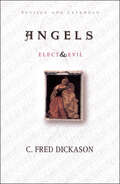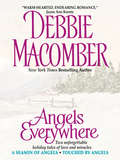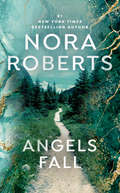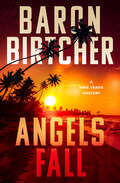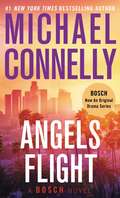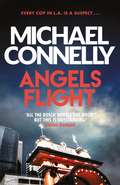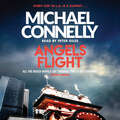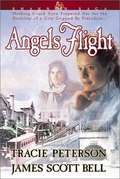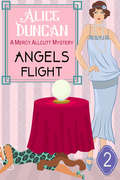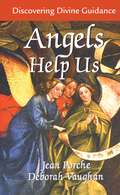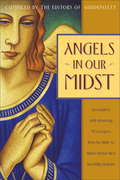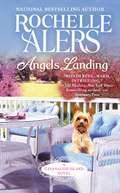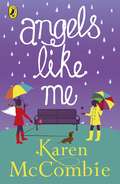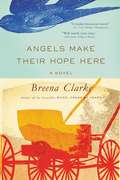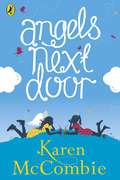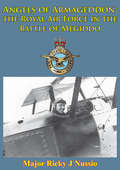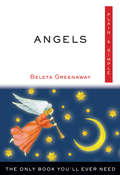- Table View
- List View
Angels Don't Know Karate (The Adventures of the Bailey School Kids #23)
by Debbie Dadey Marcia Thornton JonesThere are some pretty weird grownups living in Bailey City. But could the new karate teacher who seems to be guarding the kids and granting wishes really be an angel? The Bailey School Kids are going to find out! "Why would an angel come here?" Eddie asked. "Bailey City is the perfect place for angels," Melody said. "Not with Eddie around," Liza giggled. "That's enough to scare away any angel." "Even with Eddie," Melody argued, "Bailey City is full of nice people." "Why would an angel visit us?" Howie asked. "Maybe," Melody said slowly, "she's an angel with a mission."
Angels Elect and Evil
by C Fred DickasonWhat are angels like? How many kinds are there? Are mental disorders caused by their influence? Long favored by scholars, this classic has now been rewritten to give us accessible scriptural answers to our questions about the spirit world.
Angels Elect and Evil
by C Fred DickasonWhat are angels like? How many kinds are there? Are mental disorders caused by their influence? Long favored by scholars, this classic has now been rewritten to give us accessible scriptural answers to our questions about the spirit world.
Angels Everywhere
by Debbie MacomberA Heavensent Gift of Love In a season of giving, the beloved New York Times bestselling author Debbie Macomber sends joy winging our way with two miraculous full-length novels together in one volume. Celebrate life, love, and the holiday spirit with three unforgettable heavenly helpers -- the irrepressible angels Shirley, Goodness, and Mercy -- as they work their inspiring, poignant, and sometimes hilarious magic on hearts in need.A Season of Angels Wishes for love bring hope from above. But before the angelic trio can answer the Christmas prayers of three lonely women, there are memorable lessons that must first be learned ... Touched by Angels For some, New York City can be a sad and cold place at Christmastime. But with the help of Shirley, Goodness, and Mercy, three of the city's most deserving souls will learn what miracles are all about ...
Angels Everywhere (Angels Everywhere Omnibus #2)
by Debbie MacomberA Heavensent Gift of Love In a season of giving, the beloved New York Times bestselling author Debbie Macomber sends joy winging our way with two miraculous full-length novels together in one volume. Celebrate life, love, and the holiday spirit with three unforgettable heavenly helpers -- the irrepressible angels Shirley, Goodness, and Mercy -- as they work their inspiring, poignant, and sometimes hilarious magic on hearts in need. A Season of Angels Wishes for love bring hope from above. But before the angelic trio can answer the Christmas prayers of three lonely women, there are memorable lessons that must first be learned ... Touched by Angels For some, New York City can be a sad and cold place at Christmastime. But with the help of Shirley, Goodness, and Mercy, three of the city's most deserving souls will learn what miracles are all about ...
Angels Exist
by Luis VendramelDurvalino, Durval to his friends, who works in a public repartition and who watches from the fountain at the end of the day Carmen, a seductive secretary. Perhaps a fixation, maybe a woman's enchantment or just a distraction. However, he notices other things, specially where he works and in the imperfect world around him. Disillusionment! Barbara, the redheaded girl who is hit by her stepfather and who Durval saves. The begining of something bigger, a metamorphosis. The saxophonist of a magic sound, Louis Brother, from the lower city, would say the neighborhood is bohemic and the den of doom: "a man changes the world." an affirmation taken seriously by Durvalino. And the angels have wings... Otherwise they are not angels. Little Barbara's conviction. And then, the angel emerged and changed the world.
Angels Fall
by Nora RobertsThe sole survivor of a brutal crime, Reece Gilmore is on the run, desperately fighting the panic attacks and the nightmares that haunt her. She doesn't intend to stay in the sleepy town of Angel's Fist one second longer than she needs to, despite its friendly - if curious - inhabitants, and the irresistible attraction of local writer Brody. However, on a hike into the mountains she witnesses a couple having a vicious argument that culminates in murder. Faced with a lack of evidence, the authorities in Angel's Fist find it hard to believe Reece's story. But when a series of menacing events prove that someone wants her out of the way, Reece must put her trust in Brody - the one person who does believe her - to find the murderer before it's too late.
Angels Fall
by Nora RobertsNumber-one New York Times bestselling author Nora Roberts explores the wilds of the Grand Tetons--and the mysteries of love, murder, and madness--in her engrossing and passionate new novel. The sole survivor of a brutal crime back East, Reece Gilmore settles in Angel's Fall, Wyoming--temporarily, at least--and takes a job at a local diner. One day, while hiking in the mountains, she peers through her binoculars and sees a couple arguing on the bank of the churning Snake River. And suddenly, the man is on top of the woman, his hands around her throat... By the time Reece reaches a gruff loner named Brody farther down the trail, the pair is gone. And when authorities comb the area where she saw the attack, they find no trace that anyone was even there. No one in Angel's Fall seems to believe Reece--except Brody, despite his seeming impatience and desire to keep her at arm's length. When a series of menacing events makes it clear that someone wants her out of the way, Reece must put her trust in Brody--and herself--to find out if there is a killer in Angel's Fall, before it's too late.
Angels Fall (The Mike Travis Mysteries)
by Baron BirtcherThe case of a missing Hawaiian girl reveals the dark side of paradise for a former cop in this tropical noir crime thriller from the author of Ruby Tuesday. Retired LAPD detective Mike Travis has put thousands of miles between himself and his former life by sailing to Kona, Hawaii, where he runs a private yacht charter business and co-owns a coffee farm. But once a cop, always a cop—especially when someone he cares about needs his help. When a local girl goes missing, her fundamentalist parents don&’t even file a report. She is eighteen, after all, and seems to be rebelling against her strict upbringing. But Travis knows the dangers that lurk for young women. On an island trying to keep its traditions from being eroded by outside forces, a perfect storm of misguided morality, malice, and murder threatens the most innocent among them. And Travis will do everything in his power to turn the tide . . . &“The contrast between the dark and sometimes lurid environment in which Mike finds himself and the nearly idyllic image that many people have of the islands is almost surreal and stylishly accomplished . . . As a suspense thriller with a number of unexpected plot twists, it works well.&” —Mysterious Reviews
Angels Flight (Harry Bosch #6)
by Michael ConnellyNew York Times bestselling author Michael Connelly sets his novels of suspense against a world divided by race, politics, money, and the media. Here he thrusts Detective Harry Bosch on a harrowing journey into a high-profile murder case--and darkness...An activist attorney is killed in a cute little L.A. trolley called Angels Flight, far from Harry Bosch's Hollywood turf. But the case is so explosive--and the dead man's enemies inside the L.A.P.D. are so numerous--that it falls to Harry to solve it. Now the streets are superheating. Harry's year-old Vegas marriage is unraveling. And the hunt for a killer is leading Harry to another high-profile L.A. murder case, one where every cop had a motive. The question is, did any have the guts?
Angels Flight (Harry Bosch Series #6)
by Michael ConnellyA lawyer is found murdered on the eve of a landmark trial at the foot of Angels Flight in the heart of downtown Los Angeles. The superb sixth Harry Bosch novel from the award-winning No. 1 bestselling author. BOSCH TV STARTS FEBRUARY 2015.Harry Bosch finds himself yet again in charge of a case that no one else will touch. This time his job is to nail the killer of hot shot black lawyer Howard Elias. Elias has been found murdered on the eve of going to court on behalf of Michael Harris, a man the LAPD believes guilty of the rape and murder of a twelve-year-old girl. Elias had let it be known that the aim of his civil case was not only to reveal the real killer but to target and bring down the racist cops who beat up his client during a violent interrogation. Now it's all down to Bosch - and he's got to take a long, hard look at some of his colleagues in a police department that is rife with suspicion and hatred.
Angels Flight (Harry Bosch Series #6)
by Michael ConnellyHarry Bosch finds himself yet again in charge of a case that no one else will touch. This time his job is to nail the killer of hot shot black lawyer Howard Elias. Elias has been found murdered on the eve of going to court on behalf of Michael Harris, a man the LAPD believes guilty of the rape and murder of a twelve-year-old girl. Elias had let it be known that the aim of his civil case was not only to reveal the real killer but to target and bring down the racist cops who beat up his client during a violent interrogation. Now it's all down to Bosch - and he's got to take a long, hard look at some of his colleagues in a police department that is rife with suspicion and hatred.Read by Peter Giles(p) 2013 Hachette Audio
Angels Flight (Shannon Saga #2)
by Tracie Peterson James S. BellHaving taken Los Angeles by storm, Kit finds herself in a political storm when her next case crosses racial lines. Shannon Saga Book 2.
Angels Flight: Historical Cozy Mystery (Mercy Allcutt Mystery #2)
by Alice DuncanFamed Gossip Columnist Murdered at Séance in Angels Flight, a Historical Cozy Mystery from Alice Duncan--1926, Los Angeles, CA--Mercy Allcutt is thrilled with her new job as secretary to private investigator Ernie Templeton—until she opens the door and discovers her mother on the doorstep.Known to her friends as Honoria and to her daughters as the Wrath of God, Mrs. Allcutt is the last person on earth whom Mercy wants to see--barring a couple of cold-blooded murderers she’s met in the past few weeks.But more surprises lay ahead for the aspiring sleuth: a couple of phony spiritualists, a Hollywood gossip columnist who gets bumped off during a séance, a semi-famous starlet, and several other colorful characters. Soon Mercy finds herself in very deep waters indeed.Publisher Note: Readers who enjoy cozy mysteries in historical settings are sure to appreciate the Mercy Allcutt series set in 1920s Los Angeles, California. No vulgarity or explicit sex for those who appreciate a clean and wholesome read.The Mercy Allcutt Mystery SeriesLost Among the AngelsAngels FlightFallen AngelsAngels of MercyThanksgiving Angels
Angels Go Naked: A Novel in Stories
by Cornelia NixonMargaret Rose is a talented but nervous violinist given to bouts of stage fright and unrequited love; Webster Hale is a biologist who, on principle, refuses to kill animals in order to study them. In Angels Go Naked, a novel told in stories, Cornelia Nixon, a writer whose gift is apparent on every page, follows this vexed love story and the collision course they call their life together.Their connection is never in doubt, though Webster is appalled by the urban underbelly of Chicago, which Margy calls home. He refuses to have children because the earth is overrun with humans, and Margy feels compelled to expiate an early abortion by having a live child. Webster's gloomy view of global disaster threatens to triumph in the final story, as their close friend Calvin is dying of AIDS beside a moribund Lake Michigan. Meanwhile, the one child Webster has agreed to conceive appears destined for stillbirth because Margy herself was poisoned as a fetus by misguided medical intervention.At the end of this sad, funny, moving tale, there may be hope, as life and love prove unexpectedly resilient, even in the twenty-first century.
Angels Help Us: Discovering Divine Guidance
by Jean Porche Deborah VaughanWhy do angels so fire the imagination of people today? Connecting with heavenly friends who watch over us, and care for us, brings great comfort in pain or stress. It also takes us into the realm of the divine, where we find guidance and companionship for the soul. This lively overview explores historical and scriptural accounts, traditions from around the world, and diverse contemporary views about angels. There are stories of angelic encounters with ordinary men and women, and meditations for inviting angels to act in your life.
Angels In Our Midst: Encounters with Heavenly Messengers from the Bible to Helen Steiner Rice and Bil ly Graham
by GuidepostsAngels In Our Midst is a special Guideposts collection of true stories in which ordinary human beings have had rather extraordinary encounters with heavenly messengers. In the Bible there are angels to be read about from Genesis to Revelation, and you'll find many of them in the pages. You'll even meet angels who visit us today a learn a bit about the messages they have to convey. In this book you are invited to ponder the tales of ministering spirits who by their presence provide not just succor, but the reassuring evidence of a loving God who is forever watching over us. And when you finish it's likely you will have a new appreciation of phenomenon that heretofore you may have only sensed. This inspirational book of angels will cause you to look back over your life and recall certain inexplicable happenings that left you puzzled or in awe. It is then that you will understand some of the mystery and beauty of the events related in these stories. Gradually your understanding will deepen, so that you, too, may hear what the poet Betty Banner has heard as "the swish of passing wings." Angels In Our Midst was created by the editors of Guideposts Magazine, a monthly magazine filled with true stories of people's adventures in faith. Founded by the late Norman Vincent Peale, the magazine appeals to a wide spectrum of American believers and has a circulation of over four million readers.
Angels In The Snow
by Melody CarlsonFaith, hope, and love can triumph through even the darkest hours. Looking for solace after losing her husband and young son, artist Claire Andrews flees to a cabin in the Cascade Mountains. Even there, she finds she is too distracted by her sorrow to continue painting. As Claire walks through the woods each day, she discovers two mysterious sets of footprints in the snow, an adult's and a child's. Is it her imagination? Where are they coming from? And how is it that the tracks are gently leading her to paint and to hope once again?
Angels Landing (Cavanaugh Island #2)
by Rochelle AlersSometimes love can take you by surprise. Kara Newell has a big-city life that needs a major shake-up. Her dedication as a social worker is unwavering, yet her heart tells her that there is more to life than just work. Kara gets the push she needs when she shockingly inherits a large estate on an island off the South Carolina coast. Now the charming town of Angels Landing awaits her . . . along with a secret family she never knew she had.After surviving war, loss, and heartbreak, ex-marine Jeffrey Hamilton takes his position as sheriff of idyllic Cavanaugh Island very seriously. So he is the perfect person to watch over the beautiful, confident woman who has turned her new family's expectations upside down-and stepped into the crosshairs of angry local residents. But soon Kara becomes more than just a job to him, and he begins to need her in ways he never expected. As Kara and Jeffrey confront the town gossips together, they'll learn to face their fears and forgive their pasts in order to find a future filled with happiness in Angels Landing.
Angels Like Me: (Angels Next Door Book 3) (Angels Next Door #3)
by Karen McCombieAngels Like Me is the third title in the enchanting and magical friendship series from bestselling author Karen McCombie that began with Angels Next Door.Riley's best friends, the Angelo sisters, are special. Sparkly, strange and full of secrets . . Life at home is tricky for Riley Roberts. She misses her mum and wants to learn more about her. But Dad is as secretive as ever.She hopes the sisters can work their magic and help her find out the truth. But Riley is about to discover something more magical than she could have imagined - something that could bring her closer to her mum and answer her questions at last.About the author:Bestselling author Karen McCombie trained as a magazine journalist in her native Scotland before moving to London. After several years working on teen favourites Just 17 and Sugar, she turned to fiction, with her first series, Ally's World, becoming an instant success. In total she's had more than 70 books published and translated around the world, and more than a million books sold. Karen lives in North London with her very Scottish husband Tom, her sunshiney daughter Milly, a demented cat called Dizzy and Biscuit, the button-obsessed hamster. Angels Like Me is the third title in her Angels Next Door series.www.karenmccombie.comAlso available: Angels Next Door (book 1)Angels In Training (book 2)Angels Like Me (book 3)
Angels Make Their Hope Here
by Breena ClarkeRussell's Knob is not paradise. But already in 1849 this New Jersey highlands settlement is home to a diverse population of blacks, whites, and reds who have intermarried and lived in relative harmony for generations. It is a haven for Dossie Bird, who has escaped north along the Underground Railroad and now feels the embrace of the Smoot family. Duncan Smoot presides as accidental patriarch, protector of his enterprising sister, Hattie, and his two rambunctious nephews. As Dossie busies herself with cleaning, cooking, and tending the chickens at Duncan's homestead, she wonders: Could this man, her rescuer--so godlike in her eyes, so much older than she--expect her to become his helpmeet?. Tentatively, Dossie begins to put down roots--until a shocking act of violence propels her away from Russell's Knob and eventually into the mayhem of New York City's mean streets.With the same storytelling brio that distinguished the acclaimed novels River, Cross My Heart and Stand the Storm, Breena Clarke weaves a richly dramatic story of interracial harmony in the Civil War era--and of one woman's triumph in the crucible of history.
Angels Next Door: (Angels Next Door Book 1) (Angels Next Door #1)
by Karen McCombieAngels Next Door is a gorgeous new magical friendship series for 8+ readers by bestselling author, Karen McCombie.Riley's best friend has gone away forever and Lauren 'Queen of Everything' Mayhew is making school a nightmare. It looks like Riley's on her own, until the three Angelos Sisters move in next door.Her new neighbours are . . . different. Colourful and sparkly, they stand out. It's not just their names or how they dress - there's something magical about them. And since they arrived there have been loads of strange coincidences.Who are these new girls and what's with all the glitter?'A wonderful, funny, heart-warming and comforting tale . . . will be a success with female readers aged 9 and upwards' The School LibrarianAbout the author:Bestselling author Karen McCombie trained as a magazine journalist in her native Scotland before moving to London. After several years working on teen favourites Just 17 and Sugar, she turned to fiction, with her first series, Ally's World, becoming an instant success. In total she's had more than 70 books published and translated around the world, and more than a million books sold.Karen lives in North London with her very Scottish husband Tom, her sunshiney daughter Milly, a demented cat called Dizzy and Biscuit, the button-obsessed hamster.www.karenmccombie.com
Angels Of Armageddon: The Royal Air Force In The Battle Of Megiddo [Illustrated Edition]
by Major Gary J. MoreaIncludes World War One In The Desert Illustration Pack- 115 photos/illustrations and 19 maps spanning the Desert campaigns 1914-1918Egypt and Palestine offered the British an opportunity to fight a war of movement. Unlike the Western Front, Egypt and Palestine were undeveloped with wide expanses of land. It was ripe for the development of maneuver warfare using the mechanical products of the industrial age: motor cars, machine guns, tanks and aeroplanes. In particular, the use of aeroplanes proved vital to the successful British defense of the Suez Canal by providing reconnaissance of enemy formations and early warnings of attack. This role of the Royal Flying Corps expanded in this theater to cover the breadth and depth of British efforts at the tactical, operational and strategic levels. The strategic success of the Royal Air Force in wrestling air superiority from the Germans was the key that allowed the Egyptian Expeditionary Force (EEF) to prepare and conduct its campaign against the central powers across the plains surrounding Megiddo. It provided the EEF intelligence of enemy positions, freedom to maneuver forces undetected, and the depth to attack and rout the retreating Turkish forces to the point of annihilation. The evolution of local air superiority in Palestine, properly coordinated with the ground offensive, was the deciding factor for victory in that theater.
Angels Of The North
by Ray BanksThatcher's Britain. A boom time for entrepreneurs, patriots ... and vigilantes.<P> Gateshead's notorious Derwent Hall estate. Crippled by unemployment, awash with drugs, and a no-go area for police and politicians alike.<P> Three men – a taxi driver with political aspirations, a soldier with black dreams, and the jobless victim of a brutal attack – come together to rid their estate of crime. But when conscience collides with ambition, it's not long before the streets turn bloody and their community burns.
Angels Plain & Simple: The Only Book You'll Ever Need (Plain & Simple Series)
by Beleta GreenawayThroughout time, people of many cultures and religions have believed in angels. Now Beleta Greenaway brings you closer to these wonderful beings in this delightful guide. She shares some of her own experiences with angels and describes how you can make your own connections with them, whether through meditation, in dreams, using decks of special cards, or by other means. <P><P>Greenaway covers the entire angelic realm. Included here are: <li>Encounters with angels <li>Angels in the modern world <li>Angelic herbs and plants <li>How to work with angels <li>Angels, animals, and heaven <li>Angels in the Afterlife <P><P>This is for anyone who is interested in angels, who wants a little supernatural help, and/or who wants a glimpse of the vast array of other worldly forces and beings that inhabit the universe.

